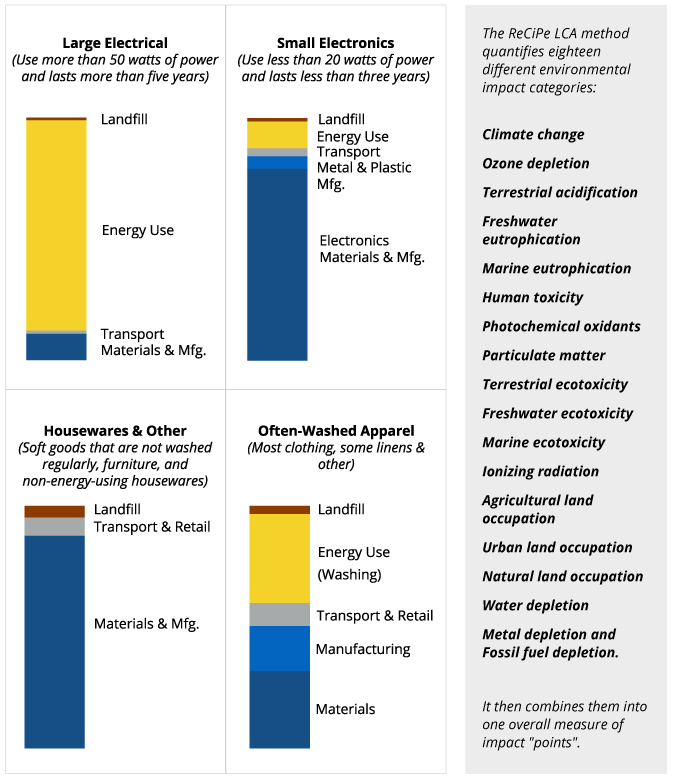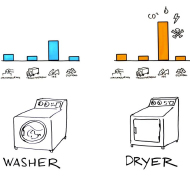measuring sustainability
Content
Life-Cycle Assessment
 Goal: Quantify the environmental impacts of your product and compare different scenarios.
Goal: Quantify the environmental impacts of your product and compare different scenarios.
One of the best ways to quantify the environmental impacts of your product or service is life-cycle assessment (LCA). A carbon footprint is a kind of LCA that only measures greenhouse gas emissions, but LCAs can quantify and compare many different types of environmental impacts, from carcinogens to land use to mineral depletion and more. The “ReCiPe” methodology measures eighteen impact categories and can graph them all on one scale for the whole life-cycle of your product. The “eco-cost” methodology measures twelve impact categories and graphs them all as financial costs to society (in €). This helps you determine your priorities for green design. For example, here are very rough LCA graphs of typical products in four different product categories:

Rough single-score LCA graphs for four types of products. Image Credit: Faludi MCAD Class 2014.
More pre-calculated LCAs available at ProductDesign.green.
These graphs combine all of the different impact categories mentioned above, to show the biggest opportunities for improvement. For “large electrical” it is reducing energy use or switching to clean energy, and for “housewares and other” (such as furniture), it is choosing better materials and manufacturing methods, etc. However, sometimes the opportunity is not as clear. Notice that in the “often washed apparel” graph, energy and material impacts are similar; in this case, there are large uncertainties for knowing which impact is actually larger.
Watch out: some assumptions can change impacts by orders of magnitude! To avoid this, you can use sensitivity analysis to check your assumptions by trying different inputs or methods. Only trust large differences until you have more precise analyses.
Here is an hour-long video introduction to LCA, describing what it is used for, what is measured, and how to do it:
How To Do LCA
Your estimated LCA for early-stage design will not be rigorous, like the analysis you would need for an Environmental Product Declaration. A properly rigorous LCA can take six months or more to do, but an estimated LCA can take hours. As above, remember rough analyses can have huge uncertainties (such as 30%, 50%, often 100% or more, per datapoint). Only trust large differences until you have more precise analyses. The resources below can be combined with the LCA Exercise so that you can do your own.
You can get a basic working knowledge of how to do LCA from the primer below (similar in content to the video lecture above):
Autodesk Sustainability Workshop – LCA Primer
You can do your own LCA using this template calculator spreadsheet. The spreadsheet contains a copy of the open-source IDEMAT database, and a template for doing analyses with it. This 50-minute video takes you through the exercise (linked to at the bottom of this page, and the left-hand sidebar), demonstrating everything step-by-step. (Note the spreadsheet in the video is an older version.)
Instead of the template spreadsheet, you can use LCA software like the SustainableMinds web app, or make your own spreadsheet with data from lookup tables like the Okala or Ecolizer PDF table. For advanced modeling, professional experts usually use SimaPro or GaBi. These include larger databases and can calculate statistical distributions of uncertainty, among other features.
For further details on LCA and modeling complicated situations such as multiple life-cycles of reuse and recycling, see the TU Delft LCA guide. or the MOOC from the joint TU Delft – Leiden University masters program on Industrial Ecology. SustainableMinds also has a good description of how to choose functional units.
All VentureWell Tools for Design and Sustainability content is shareable and usable by CC BY-NC-SA 4.0 license.
